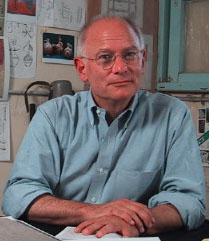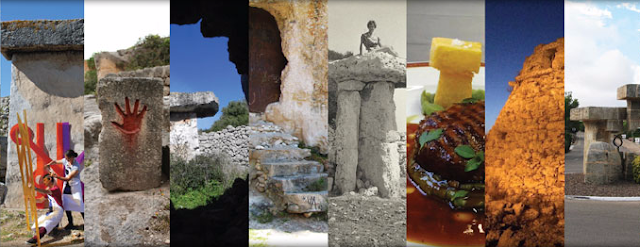INTERVIEW WITH... Neil Silberman
 Neil Silberman is coordinator
of projects and policy initiatives in the Centre for Heritage and Society of
the University of Massachusetts- Amherst (USA), and one of his founders. He is
also professor of the Department of Anthropology of that university and
president of the ICOMOS International Scientific Committee on Interpretation
and Presentation. Besides, he is editor and co-editor of several reviews such
as Oxford Companion to Archaeology or Heritage and Society. A prolific author,
he has written books about the history and politics of the archaeology in the
Middle East, more than 50 journal articles and participated in the edition of
several books with different topics related to archaeology.
Neil Silberman is coordinator
of projects and policy initiatives in the Centre for Heritage and Society of
the University of Massachusetts- Amherst (USA), and one of his founders. He is
also professor of the Department of Anthropology of that university and
president of the ICOMOS International Scientific Committee on Interpretation
and Presentation. Besides, he is editor and co-editor of several reviews such
as Oxford Companion to Archaeology or Heritage and Society. A prolific author,
he has written books about the history and politics of the archaeology in the
Middle East, more than 50 journal articles and participated in the edition of
several books with different topics related to archaeology. Hello Neil,
“Perception and Interpretation” is
probably the hotchpotch of this conference, plenty of topics to cover. You are
very critique with the traditional way of unidirectional interpretation and
communication in heritage, as if the public was a passive audience. Which are,
in your opinion, the reasons why?
Single stories make me
nervous, especially when they come down from above. In heritage, there is a
tradition of “expert” interpretation that can be used to instil what Laurajane
Smith has called the “Authorized Heritage Discourse”—and orthodox
interpretation of a site or a landscape that sanctifies a certain system of
power and socio-economic status quo.
In her fascinating TEDtalk (certainly worth watching if you haven’t seen it), the Nigerian writer
Chimamanda Nogozi Adichie has warned us of the danger of a single story —not
only because it bears a subtle yet powerful ideological message, but also
because it dehumanizes and renders invisible those groups and individual whose
stories are not told.
That kind of erasure
is a powerful effect of the single story, whether it is told by a totalitarian
government or by the mayor of a small town. We must remember that the past has
no single objective significance without reference to the present, and in
heritage as in politics, each individual has a unique perspective on what that
significance is. None of us are empty vessels, who need to be filled with the
ideological certainty of someone else’s tale.
Reflection about the past needs to take the form of a public discussion,
not a monotonous monologue.
The construction of the public image
of heritage has a lot to do with perceptions and interpretations that are way
beyond our control nowadays (television, advertising, tourism, politics, etc.).
Are we prepared to become a part of it? Should we anyway?
I have to disagree
with the two premises of this question: 1.) that the public image of heritage
is way beyond our control and 2.) that there is any possibility that we—as
scholars, professionals, or just living breathing can possibly ever remain
completely apart from public culture. Both these ideas, I am convinced, are evidence of just how embedded in
contemporary culture we are, even when we think we are doing “pure” research
and stay uninvolved in things like tourism, promotional videos, and
nationalistic films.
We definitely do
have control over the public image of heritage is what we make it—or what we
allow it to be. I get absolutely furious when I see archaeologists exploiting
the image of Indiana Jones to recruit volunteers or raise funds. That image of
the intrepid adventurer retrieving treasures from a realm of darkness and
threatening barbarians who cannot grasp the true significance of the artifacts
is a nasty imperialist trope. We can and must contest that image
by utilizing all the many digital media at our disposal to encourage people to
create new characters and new stories that depict the significance of the past
for them.
Engagement with the
public and the encouragement of a public multilogue about the past is the only
way to smash the authoritarian idea that history is a fixed narrative and that
the economic inequalities and power relations of the present are its inevitable
culmination. When we “withdraw” from civil discussion and public culture we
merely strengthen the harmful stereotypes of the great white explorer and
all-knowing expert. Cultural heritage, after all, is not a static body of
knowledge but an evolving collective creative endeavour that we must all
contribute to and pass on.
Dealing with popular images of the
past is a tricky path. World Heritage should be the spearhead of management and
so, it should also deal with these issues. Do you think sites are currently
working on inclusive interpretation and outreach strategies?
Unfortunately,
no. Because UNESCO World Heritage sites
are nominated by states-parties, it is unlikely that they will express local or
personal values rather than the prestige of the modern nation-state they belong
to and hard to imagine that they would ever commemorate events and ideas that
are openly hostile to the particular state.
That obviously leaves out a large proportion of human experience. But there is another, even more powerful
challenge to be overcome. The physical form of the modern World Heritage site,
with its carefully drawn boundaries and buffer zone (not to mention its
entrance gate and ticket booth) is a construct that is consciously separated
from the conflicts and uncertainties of the present. It is in many cases a
place of escape from the present, a nostalgic entertainment venue. In many
cases, especially but not exclusively in the developing world, the members of
local communities see such sites as a modern places of employment and revenue
generation, meant to serve other peoples’ dreams. Inclusive interpretation must include the
link between past and present; outreach strategies are only necessary when
there is an “outside” that the insiders decide they must reach. We need a new multivocal paradigm for
World —and every other type of— Heritage.
The Nara+20 document indicates that
“Those with authority to establish or
recognize the significance, value, authenticity, treatment and use of heritage
resources have the responsibility to involve all stakeholders in these processes,
not forgetting those communities with little or no voice”…According to some
claims, the concept of authenticity helps to bestow even more authority to
heritage professionals, what is your stand regarding this issue?
The concept of
Authenticity is a kind of moral absolute like “beauty”, “truth”, and
“righteousness” that we have learned to be very cautious of. At the time of the
drafting of the World Heritage Convention in the early 1970s, European and
North American conservation theory which privileged a certain, highly
materialistic concept of heritage reigned supreme. The 1994 Nara Document then came along and
said that notions of authenticity can be different in different cultural
contexts. That was a major breakthrough,
but still required the services of experts in each cultural area to attest to a
site’s authenticity. In the formulation
of the recent Nara + 20 text, we in the drafting committee recognized that even
within distinctive cultural areas, ideas about the significance of heritage are
highly varied and constantly evolving.
It may be quixotic to expect that official cultural institutions with
legal authority will willingly respect the perspectives of those stakeholders
with no power—but it is part of a new approach that seeks to promote public
discussion about the significance of the past, not stifle it.
In connection with the last
question, you consider in your blog Searching
for Authenticity that “[authenticity] is
not inherent in the place or object but rather evokes a feeling of continuity
and familiarity with the values, something that evokes a deep emotional
connection and response” (Silberman 2014). Can change in these places or
objects still create that sense of continuity? Do these sites necessarily be
preserved to produce such responses? Are these emotions commoditized and
adapted to “popular” ideas of such places by tourism industry?
First
of all, we need to stop thinking of heritage as the things that are necessarily
continuous with the past. I will leave to the side the question of touristic
commodification, since that is just a fetishization of the belief that heritage
is both continuous and unchanging—and can be purchased in the form of
“traditional” dance performances, handcrafts, and exotic meals. In the contemporary world change is often so
far-reaching that it destroys continuity and that is something that I am increasingly
becoming conscious of. The traditional definitions of heritage authenticity
exclude all that is dis-continuous, for example newly built theme parks and a
landscape of gleaming skyscrapers where vernacular architecture once stood.
Certainly people today desperately seek a deeper emotional connection with the
places they live and work, but it is increasingly commonly achieved through the
fraudulent authenticities of historic shopping districts, on the one hand, and
the all-too common fundamentalist insistence on cultural purity by various
nativist groups all over the world, on the other. It is clear that authenticity
is not inherent but ascribed. As you suggest, the ascription can be superficial
or kitsch. Yet my interest these days goes beyond whether “authenticity” is
genuine or commodified. It is: what deeper
socio-economic circumstances is the modern craving for “a feeling of continuity
and familiarity” symptomatic of?
From your long trajectory working on
this subject, which would you think is the most current topic to focus on nowadays?
I
believe the most pressing topic to explore is the social, cultural, and
political impact of the disintegration of collective memory. Or rather should I say the continual, rapid
fragmentation and recombination of particular collective memories in the kaleidoscopic
reality of the digital age.
References:
- ICOMOS (2014): NARA+20: On heritage Practices, Cultural Values, and the concept ofAuthenticy. [10/04/2015]
- Silberman, N. (2014): The Search Goes on, but… 25th April 2014. Searching for Authenticity: Field Notes from a Globalized and Tribalized World [online]. [10/04/2015]



Comentarios
Publicar un comentario